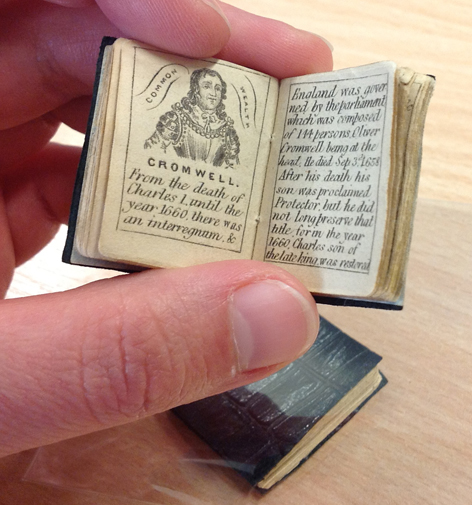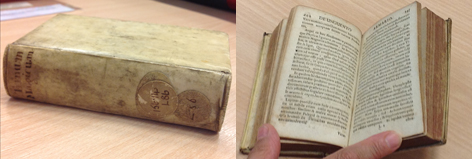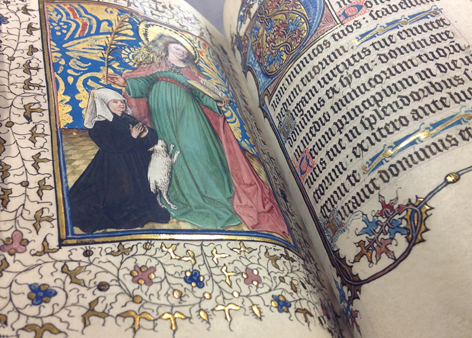ARLIS visit
You know me, I am all about the paper. However, from the conservation perspective, the one thing that terrifies/fascinates me are books and book bindings. I would love to, sometime in the future, study further with a focus on early book bindings, but for now I just admire and respect them from (very) afar and envy those that get to work with these beautiful objects.
Last Friday I had the absolute pleasure in visiting the Brighton and Hove Jubilee Library Rare Books and Special Collections section by joining the morning session of the ARLIS (Art Libraries Society) Professional Development Committee organised day of visits – of which the afternoon session was a visit to us here at the Design Archives.
We were welcomed to the Jubilee Library by Margaret Curson, who is the one part-time staff member at the Rare Books and Special Collections section of the Library. Aside from the Jubilee Library collection, Hove Museum & Art Gallery and over 1000 books held at the Royal Pavilion library are also covered.
The library was first opened in 1873. Most of the items in the Rare Books collection have been donated rather than collected, which is unusual for a public library. The Rare books now consists of 45 000 items, all of which have been catalogued using the Dewey system with the aid of Heritage Lottery funding, and are searchable online. The new Jubilee Library, which was opened on World Book Day (3 March) in 2005, also now has storage with environmental controls – before the new premises, the collection was housed in different locations. None of the library has been digitised and only parts of the collection have been conserved.
Margaret Curson was giving us an overview on the wonderful spread of books she had prepared for us, and said that she would like to get the Captain Cook catalogue of cloth specimens (above) conserved when the time is right. This was a fascinating bound specimen of cloth samples from 1787, collected by Captain Cook on his three voyages to the Southern Hemisphere. The samples were put together by Cook’s First Officer and Navigator on their visits to the Islands and also includes anecdotes on what happened to the crew among the natives. There are 6 copies of this sort in the UK, so it was a privilege indeed to be able to handle this.
It was hard to choose favourites among the books laid out for us, but the miniature books have got to be a very strong contender for me – these were two tiny books on the History of Britain in two volumes. Absolutely adorable!
The most fascinating by all accounts was the above book, which is allegedly bound using human skin. The reason this is thought to be the case is that you can not detect any pores on the actual surface of the leather. However, the library has not yet tested the book to confirm or deny the material, so time will tell. The contents of it are also extra fascinating: it is a book of magic from the 17th Century. Now if only I could read Latin….
I am still overwhelmed by all the gorgeous things we saw, but on the ‘most beautiful’ category would have to be the velvet bindings of a pair of 18th Century German books – the metal details on the corners and the lock system were absolutely mouth-watering. I can imagine this causing a few head-scratches among the book conservators out there!
As an example of a different type of book binding, the above is a concertina bound Siamese manuscript consisting of imagery in folklore and religion.
We were also shown Shakespeare’s second folio from 1632, an early printed chronicle from 1493 with woodcuts all the way through it, hand painted and coloured Japanese concertina print books and of one of their earliest books from 1270 – a manuscript given to the collection by two local ladies with illuminated letters and paintings, to name a few.
The variety of books the collection holds is staggering – the staff and volunteers are still constantly discovering more and more gems. The collection is very strong on the arts, architecture, theology and travel but covers surprisingly varied subject areas, considering its origin of donations.
The ARLIS group visited us in the afternoon with a talk given by our Deputy Curator Dr Lesley Whitworth and our Archivist Sue Breakell, introducing our collections and history. We all hope that everyone had a thoroughly enjoyable day down here by the seaside – I know for a fact it inspired me!








Due to a migration of this blog to a new layout, all comments made to posts have been lost in the process. Below are the comments, with name, date and time, made for this post.
Alison Brown 27 Jun 2013 3.36pm
Thank you for posting this, Sirpa – I hadn’t taken any pictures of the fabulous books at the Jubilee Library so it’s lovely to see yours! I too found it an inspiring day at the seaside.
Sirpa Kutilainen 27 Jun 2013 3.44pm
Thank you very much! I’m afraid I can sometimes get a little carried away with the picture-taking, it felt a mission to try and pick only a few to post on the blog….!